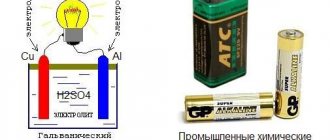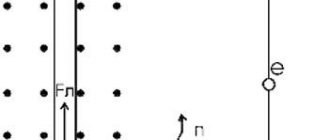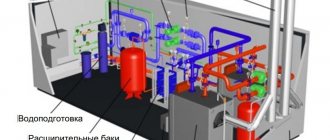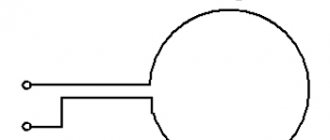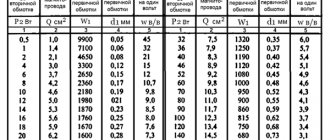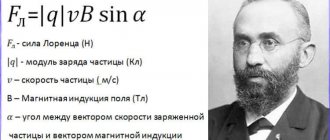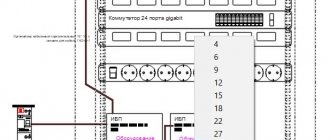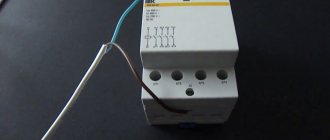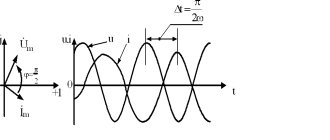Imagine, you and your child are getting ready to watch a cartoon or an educational program, lay down on the sofa, and suddenly your child asks: “What makes the TV/phone/tablet work?” It seems that the answer is simple - from electricity, but you don’t need to be Nostradamus to predict the next question that will come from a child: “Where does electricity come from?” And here many parents are stupefied, especially those who did not finish physics and mathematics, and their profession is in no way connected with this direction.
Of course, you can answer as simply as the previous question: “Electricity comes from the outlet.” But so that your child receives a complete and clear answer, in an accessible and understandable language, without abstruse formulas and definitions that most physics textbooks are written in, we suggest staying on this page and reading, perhaps not new, but useful and informative information.
What is electricity?
The word “electricity” itself, or more precisely, “electric” force, appeared more than 2000 years ago in Ancient Greece. People have noticed that if you rub amber on wool, the stone begins to attract various small objects. Amber in ancient Greek was called “electron”, hence the name itself.
But the study of the mysterious phenomenon did not progress beyond simple experiments with static electricity among the Ancient Greeks. And the essence of the whole phenomenon began to be revealed much later. Scientists have found that surrounding objects consist of elementary particles: protons and electrons. These two types of particles have an electric charge: the electron has a negative charge, but the proton has a positive charge. Attracted to each other, they closely interact and, depending on the number of protons and electrons, form atoms of different matters.
The protons themselves are located in the nucleus of the atom, but the electrons rotate around them in a circle. Atoms with the same number of protons as the number of electrons have zero charge. For example, if an amber stone lies on its own and no one touches it, then its atoms also have zero charge. But if you rub amber atoms against wool atoms, the electrons from the wool will instantly move to the amber ones, and their “excess” will make the charge negative. Such a pebble with “new strength” begins to attract small objects with a zero or positive charge, and if the object has a negative charge, it will repel them.
How safe is nuclear energy?
Cooling pond at NV NPP
When properly operated, a nuclear power plant is completely safe. The radiation background in a 30 km zone around the Novoronezh Nuclear Power Plant is monitored by 20 automatic posts. They operate in continuous measurement mode. In the entire history of the station's operation, background radiation has never exceeded natural background values. But nuclear energy has potential dangers. Therefore, every year safety systems at nuclear power plants become more and more advanced. If for the first generations of nuclear power plants (1.2 power units) the main safety systems were active, that is, they had to be started by a person or automation, then when designing generation 3+ units (6th and 7th power units of the Novovoronezh NPP), the main emphasis is placed on passive safety systems. In the event of a potentially dangerous situation, they will work themselves, obeying not a person or automation, but the laws of physics. For example, when there is a blackout at a nuclear power plant, the protective organs, under the influence of gravity, will spontaneously fall into the core and shut down the reactor.
Nuclear plant personnel regularly train to cope with various types of emergencies. Emergency situations are simulated on special full-scale simulators - computerized devices that are outwardly indistinguishable from control panels. The operating personnel managing the reactor receives a license from Rostekhnadzor every 5 years for the right to conduct the technological process (control the NPP unit). The procedure is similar to obtaining a driver's license. The specialist passes theoretical exams and demonstrates practical skills on a simulator. Only having a license and passing NPP exams are personnel allowed to operate the reactor.
As an advertisement.
Electric current is an organized group of electrons
But how does electricity live in an outlet if everything is so dispersed in this circuit?
Almost all atoms can lose and gain electrons. So, if some have an excess of them, and others have a deficiency, then the electrons directed by electrical forces will rush to where they are lacking. This flow is called electric current.
Among the concepts familiar to us, electric current is similar to a river, which, spilling into many branches, powers electrical appliances. But before sending this stream of negatively charged particles, do they need to be taken from somewhere?
The best minds of the last millennium struggled with this issue, but the first to make a breakthrough was the Italian scientist Alessandro Volta, who in 1800 invented the first battery, called the “Volta Pillar,” thereby giving the world a reliable source of constant electricity. In gratitude for such a discovery, the scientist’s name was immortalized, and since that time, current voltage has been measured in volts.
Slide captions:
Where does electricity come into our home? Khrycheva T.P.
RIDDLE It will blink, blink, dive into the bubble, into the bubble under the ceiling - It’s daylight in the room at night!
What did people use in ancient times to make it light?
In ancient times, people had only the fire of a fire to shine at night.
Over time, people realized that if you put a stick in a fire, it would light up. This is how the torch appeared.
Later, smaller sticks called torches began to be used in houses. They placed the torches on a special stand - light.
Over time, people began to pour oil into a small bowl, put a thread wick in it and set it on fire. This is how oil lamps came into being.
And even later, people came up with a candle.
One day, a smart man invented an electric light bulb. It burns brightly, comfortably and safely.
What makes a light bulb work? I run along the paths, I can’t live without a path. Where am I, guys, no light in the house? To distant villages, cities Who is walking on the wires? Serene Majesty This
Electric charges in nature
Electric current is a flow of tiny charged particles - electrons. It is similar to a river, only water flows in the river, and electrons flow through the wires. Electric current is produced by large power plants.
Electric current first flows through thick high-voltage wires, then through ordinary wires it flows into our apartments, ending up in switches and sockets.
How does electricity help us? Divide into 2 groups
REMEMBER THE RULES! When you leave home, turn off the lights and electrical appliances!
Where does electricity come from?
Despite the fact that the “Volta Pillar” made a breakthrough in the science of that time, over the next 200 years a lot of more global discoveries were made and many ways to produce electric current were discovered, for which huge structures were built and the latest technologies were used! And now, in order.
TPP - thermal power plant
To generate current, a turboelectric generator is installed at the thermal power plant, consisting of:
- the fixed part is a stator in the form of a bipolar magnet;
- a rotating rotor, which is wound with copper wire, since this metal is considered the best and most accessible conductor.
The continuous rotation of the magnet constantly changes the polarity (poles) causing the electrons in the wire to move, as in the example with amber and wool, only on a larger scale. But for this whole mechanism to work and electricity to be generated, “something” must spin a huge turbine. For this purpose, huge boilers are installed at thermal power plants that heat water to 450 ℃, causing it to turn into steam. Next, under high pressure, steam flows from the boiler onto the blades attached to the rotor, and starts it into operation at an incredible speed - 3000 revolutions per minute!
NPP - nuclear power plant
Here, just like in the thermal power plant, a turboelectric generator is installed, but the very dangerous, but energy-efficient Uranium-235 is responsible for heating the water. In order for it to release heat, huge nuclear reactors are built at nuclear power plants, in which Uranium-235 breaks down into small particles, which generates a large amount of energy used to heat water to steam and start a turboelectric generator.
HPP - hydroelectric power station
A safer, but no less effective way to obtain energy. Although it will require the construction of a whole chain of hydraulic structures in order to create the necessary water pressure to ensure the operation of the turbines of the electric generator. And then the principle is the same as in the previous two power plants: the rotor rotates and electricity is generated.
Wind stations
They look majestic and beautiful, and even in ancient times, with the help of the power of the wind, huge mechanisms such as windmills were put into operation.
In the modern world, they decided to improve this mechanism and use it to convert mechanical energy into electrical energy. The principle is as follows: the wind pushes huge blades, which put the generator rotor into operation, and it, as we know from the example of the first three power plants, produces current.
But in this way, with the help of one wind generator, you cannot provide even a small town with electricity, which is why a whole network of huge mechanisms, consisting of 100 or more units, is installed.
How does a nuclear power plant work?
Power unit No. 5 of NV NPP
Energy at a nuclear power plant is generated in a reactor. The fuel for it is artificially enriched uranium in the form of tablets with a diameter of several millimeters. Uranium pellets are placed in fuel elements (fuel elements) - these are sealed hollow tubes made of heat-resistant zirconium. Fuel assemblies (FA) are assembled from fuel rods. There are several hundred fuel assemblies in the VVER core - fission processes of uranium nuclei occur in them. It is the fuel assemblies that transfer energy, heating the primary coolant. The neutron density in the reactor is the power of the reactor, and it is regulated by the amount of neutron absorber-boron-containing elements introduced into the core (like a brake on a car). To produce electricity in nuclear power plants, as well as in thermal units, less than half of the heat generated is used (law of physics); the remaining heat of the steam exhausted in the turbine is released into the environment. At the first units of the Novoronezh NPP, water from the Don River was used to remove heat. To cool the third and fourth power units, cooling towers are used - structures made of iron and aluminum about 91 meters high and weighing 920 tons, where heated circulating water is cooled by air flow. To cool the fifth power unit, a cooling pond filled with circulating water was built, and its surface is used to release heat to the environment. This water does not come into contact with the primary circuit water and is completely safe. The cooling pond is so clean that in 2010 it hosted an all-Russian fishing competition. To cool the circulating water of blocks 6 and 7, the tallest cooling towers in Russia with a height of 173 m were built. From the very top of the cooling tower, the outskirts of Voronezh are clearly visible.
A little history
The world's first public power plant, Pearl Street, was built in New York in 1882. It was designed and installed by none other than Thomas Edison. And he didn’t even charge a fee for using the generated electricity until the entire mechanism worked smoothly and without interruptions.
But the “great-grandmother” of all stations could light only 10,000 lamps, although even at that time this was something supernatural. At the same time, modern power plants produce thousands of times more, providing electricity to cities with a population of 100,000 people!
When was the Novovoronezh Nuclear Power Plant built?
Construction of the first industrial unit of NV NPP
For the first time, the industrial use of nuclear energy in the Soviet Union began at the Novovoronezh Nuclear Power Plant. In September 1964, the first power unit of the NVNPP with a pressurized water reactor (VVER) was launched; its power was 210 MW - almost 40 times more than that of the first experimental nuclear power plant. This reactor model is considered one of the most technically advanced and safe in the world. The prototypes of VVER for nuclear power plants were submarine reactors. During the construction of the first power unit of the Novovoronezh NPP there were no training centers for specialists capable of operating the reactors. The first nuclear scientists were recruited from former submariners.
Five power units were built and put into operation at the Novovoronezh NPP; today three of them are operating; construction and preparation for the launch of two more new ones are underway. All power units at NVNPP with VVER reactors.
How does electric current enter homes?
After power plants generate current, it travels through a cable to a distribution substation for measurement and conversion. Transformers installed there increase the voltage to 10,000 volts. Thanks to this voltage, current is transmitted over long distances with minimal losses at an incredible speed of up to 3000 km per second!
Then the current flows to a step-down substation, where transformers reduce the voltage to 220 volts - the standard adopted in the Russian Federation. And then the electricity is sent to the city’s distribution networks, and from there to your house and apartment. This is the difficult path he takes to charge our phone, light a light bulb or make the refrigerator work.
Your house
Your electricity passes through the service and is recorded on your meter. The meter keeps track of how much electricity you use. At your distribution panel, your electricity is divided into circuits for each area of your home. Finally, the electricity travels through wires behind your walls to outlets and switches where you control your lights and appliances.
See also: How to properly and safely clean windows
It's easy to take the electricity used to light your home for granted, but this precious source of energy has traveled a long way through complex generation and transmission infrastructure to get to your home. Knowing this, you may be less likely to take electricity for granted the next time you turn on the lights or turn on the TV.
Click Energy is a leading energy company and we're helping Australian households save more on their energy bills through our 100% online service model. Find out more about our simple, straightforward plans here or go and save online today.
How does current make electrical appliances work?
But how does current manage to power electrical devices? For a visual understanding, let's take a regular incandescent lamp as a basis and return to our small particles.
As electrons travel at incredible speeds through the light bulb's spiral, they continually collide with the metal atoms that make up the spiral. The atoms wobble and their temperature rises greatly. Thus, the electric current heats the lamp spiral to 3000 degrees, causing it to begin to glow. This is why the use of any metal is not suitable for the spiral, because it will simply melt due to the high temperature.
Modern devices - mobile phones, TVs, microwave ovens - use more complex circuits, but the principle remains the same: due to the rapid flow of particles, the atoms of the conductors heat up, which releases energy and starts the devices to work.
Not only a friend, but also an enemy!
Of course, electricity is an important and irreplaceable invention for all mankind. With its help people:
- they have made and are making a lot of discoveries every day;
- treat diseases that were fatal in the past;
- drive electric vehicles without polluting the environment with exhaust gases;
- can travel the world, learn and see sights without leaving home!
All the benefits of electricity simply cannot be described in one article!
But with all this, the current can be dangerous and in a split second take the life of any living creature.
By the way, an interesting fact. Birds that sit on high-voltage wires do not receive a shock due to the fact that they receive the same voltage as in the cable itself. The fact is that they sit only on one phase, but if suddenly the bird’s tail or other part of the body touches the ground, a pole or another wire, the current will immediately hit it.
Traditional power plants
Although energy trends have changed rapidly in recent years, it is possible to identify the main types of power plants operating according to classical principles. First of all, these are thermal generation facilities. The resource is produced as a result of the combustion of organic fuel and the subsequent conversion of the released thermal energy. At the same time, there are different types of such stations, including heating and condensing. The main difference between them is the ability of objects of the second type to also generate heat flows. That is, when answering the question of where electricity comes from, we can also note stations that simultaneously produce other types of energy. In addition to thermal generation facilities, hydro and nuclear power plants are quite common. In the first case, it is assumed that energy will be converted from the movement of water, and in the second, as a result of the fission of atoms in special reactors.
Rules for safe handling of electricity for children
Young children do not understand the dangers of handling electricity. Of course, we are now not talking about toys powered by 12-volt batteries, but about a dangerous and powerful “beast” that lives in sockets. Therefore, children should not be left near sockets without special plugs, and even without parental supervision.
For older children, it is worth having a conversation and explaining the following rules. It is forbidden:
- Place or hang foreign objects on the device cable.
- Twist the cable into knots.
- Use dirty wire.
- Use an electrical appliance near heat sources: radiators, stoves, ovens, etc.
- Plug several powerful devices into one outlet at the same time. Show your child where and how you can see the power, or make a list in advance of what you can turn on and what you can’t.
- Use or try to repair a broken electrical appliance, including if the insulation (integrity) of the cable is broken, the plug is damaged, etc.
- Handle the device or cable with wet hands.
- Pull the cord (you need to unplug the device from the outlet while holding the plug).
Unforeseen situations may also arise:
- sparks from the socket;
- smoke from a cable or device;
- burning smell, etc.
In this case, it is necessary to show the child where the electrical panel is and how to turn it off, and explain that after a power outage it is necessary to call one of the adults.
